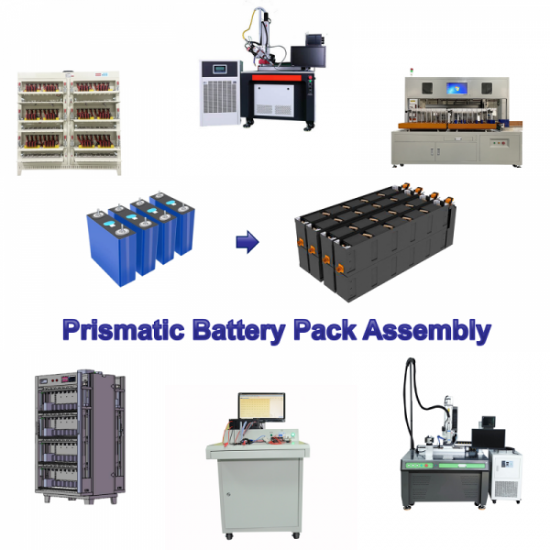Lith Corporation, founded in 1998 by a group of material science doctor from Tsinghua University, has now become the leading manufacturer of battery lab&production equipment. Lith Corporation have production factories in shenzhen and xiamen of China.This allows for the possibility of providing high quality and low-cost precision machines for lab&production equipment,including: roller press, film coater,mixer, high-temperature furnace, glove box,and complete set of equipment for research of rechargeable battery materials. Simple to operate, low cost and commitment to our customers is our priority.
What is an EV Car Battery Assembly Plant?
An EV (Electric Vehicle) Car Battery Assembly Plant is a specialized manufacturing facility focused on integrating premade battery cells into modules and complete battery packs for installation in electric vehicles.
Unlike fullscale battery cell production plants, which manufacture the individual cells from raw materials, an assembly plant primarily deals with:
Cell sorting and grouping
Module assembly (cells → modules)
Pack integration (modules → vehicleready battery packs)
Battery Management System (BMS) integration
Testing and validation of final battery systems
These plants are often part of a larger Gigafactory complex, or can be standalone facilities located near EV assembly lines to support justintime manufacturing.
They are critical for:
Automotive OEMs integrating battery packs into vehicles
Battery suppliers delivering readytoinstall packs to OEMs
New entrants in the EV market aiming to localize battery integration
Governmentbacked EV initiatives building domestic supply chains
Key Objectives of an EV Battery Assembly Plant
1. Efficient Integration of Battery Cells into VehicleReady Packs
Assemble battery modules and packs from pretested cells
Ensure compatibility with specific EV models and platforms
2. HighQuality and Reliable Battery Systems
Maintain strict quality control during assembly
Ensure electrical, mechanical, and thermal integrity of battery systems
3. Scalable and Flexible Production
Support multiple battery pack designs for different vehicle models
Enable modular design for future upgrades and new platforms
4. CostEffective Assembly Processes
Optimize labor, automation, and logistics
Reduce cycle time and improve throughput
5. Integration of Smart Manufacturing and Traceability
Use digital systems (MES, IoT) to track every battery pack
Enable predictive maintenance and quality analytics
6. Sustainability and Reusability
Design for ease of disassembly and serviceability
Support secondlife applications and recycling strategies
Core Stages in an EV Battery Assembly Plant
An EV battery assembly plant typically includes the following integrated stages:
1. Cell Receiving and Inspection
Incoming cell inspection: Verify cell voltage, capacity, and internal resistance
Sorting and grouping: Match cells with similar performance characteristics
Storage in climatecontrolled zones: Prevent degradation before use
2. Module Assembly Line
Module stacking: Arrange matched cells in series or parallel configurations
Busbar welding: Connect cells using laser or resistance welding
Thermal interface material (TIM) application: Ensure even heat distribution
Module housing: Enclose cells in protective frames with sensors
Module testing: Verify voltage, resistance, and initial thermal performance
3. Pack Integration Line
Pack frame preparation: Install cooling plates, brackets, and structural supports
Module installation: Mount and secure modules into the pack enclosure
Electrical wiring and connectors: Install wiring harnesses and highvoltage connections
BMS installation: Mount and connect the Battery Management System
Cooling system integration: Fit liquid cooling loops and insulation
Sealing and leak testing: Ensure IP67+ protection rating
4. Final Testing and Validation
Poweron test: Check BMS communication and basic functionality
Electrical performance test: Measure voltage, current, and internal resistance
Thermal performance test: Validate cooling system efficiency
Functional safety test: Simulate faults and check BMS response
Environmental testing: Exposure to vibration, humidity, and temperature extremes
Final inspection and labeling: Assign serial numbers and prepare for shipment
5. Battery Management System (BMS) Integration and Programming
The BMS is the intelligent control unit of the battery pack, responsible for:
Monitoring individual cell voltages and temperatures
Managing charge balancing and thermal regulation
Communicating with the vehicle’s central control system
Ensuring safety through fault detection and isolation
Key activities include:
Hardware installation and connection
Firmware loading and configuration
Communication protocol setup (e.g., CAN, Ethernet)
Functional safety validation (ISO 26262 compliance)
6. Clean Room and Dry Room Infrastructure
Although less extensive than in cell production, some dry room zones are required for:
BMS installation and sensor wiring
Final pack sealing and insulation
Avoiding moisture contamination in sensitive electronics
7. Logistics and Material Handling
Efficient movement of components and finished battery packs is essential:
Automated Guided Vehicles (AGVs) and conveyors
Justintime delivery of modules and components
Packaging and shipping systems for final packs
Inventory tracking and traceability systems
8. Digital Manufacturing and MES Integration
Modern battery assembly plants use smart manufacturing systems to:
Monitor production in real time
Track every battery pack from start to finish
Collect data for quality control and yield optimization
Integrate with ERP and PLM systems
Enable predictive maintenance and process improvement
Prismatic Cell Assembly Line
9. Sustainability and EndofLife Strategy
Design for ease of disassembly and serviceability
Support secondlife applications (e.g., energy storage)
Plan for recycling and material recovery
Use ecofriendly materials and packaging
Implement energyefficient lighting and HVAC systems
Types of EV Battery Assembly Plants
Depending on ownership and strategy, these plants can be categorized as:
1. OEM Battery Assembly Plants
Operated by automotive manufacturers
Example: Tesla, BMW, Ford, Rivian
Designed to support inhouse EV production
2. Battery Supplier Assembly Plants
Operated by battery companies supplying to multiple OEMs
Example: CATL, LG Energy Solution, BYD
May include packlevel customization for different clients
3. Joint Venture (JV) Assembly Plants
Collaborations between OEMs and battery makers
Example: BMW & Northvolt, Stellantis & Samsung SDI
Shared investment and expertise
4. ThirdParty Contract Battery Assembly Plants
Built for startups or new EV brands lacking inhouse capabilities
Focus on flexibility and multiclient support
Key Considerations When Building an EV Battery Assembly Plant
When planning or expanding your battery assembly plant, consider the following factors:
| Area | Consideration |
|||
| Location | Proximity to OEMs, logistics, skilled labor |
| Production Capacity | Number of battery packs per year |
| Pack Design Flexibility | Support for multiple vehicle models and platforms |
| Automation Level | Manual, semiauto, or fully automated |
| Factory Layout | Workflow optimization, clean room placement |
| Integration with OEM Systems | Compatibility with vehicle assembly lines |
| Quality Control Systems | Realtime testing and traceability |
| Sustainability Strategy | Energy use, recyclability, waste management |
| Workforce Development | Training for engineers, technicians, and operators |
| Partnerships | Collaboration with battery suppliers, OEMs, and tech providers |
Benefits of an EV Battery Assembly Plant
Accelerates EV production by ensuring a stable supply of battery packs
Reduces timetomarket for new EV models
Improves quality and consistency through controlled assembly
Supports localization of EV supply chains and job creation
Enables cost savings through automation and process optimization
Promotes sustainability through modular design and recycling
Leading Companies in EV Battery Assembly Plant Development
Here are some of the key players involved in designing and operating EV battery assembly plants:
Automotive OEMs:
Tesla (USA) – Multiple Gigafactories with inhouse pack assembly
BMW (Germany) – Gigafactory in Germany with Northvolt
Ford (USA) & SK On (South Korea) – BlueOval battery plants
Rivian (USA) – Inhouse battery pack assembly
Volkswagen Group (Germany) – Investing in European Gigafactories
Stellantis (Global) – Partnering with Samsung SDI and Factorial
Battery Suppliers:
CATL (China) – Supplies battery packs to global OEMs
LG Energy Solution (South Korea) – Building assembly plants globally
BYD (China) – Produces battery packs for its own EVs and others
Samsung SDI (South Korea) – Expanding in North America and Europe
Northvolt (Sweden) – Sustainable battery pack assembly in Europe
Equipment and Automation Providers:
KUKA (Germany) – Robotics and automation solutions
Siemens (Germany) – Digitalization and MES platforms
Trumpf, Coherent, IPG Photonics – Laser welding and cutting systems
B&R Automation (ABB subsidiary) – Smart manufacturing systems
Hanson Robotics, Gree EnergyTech – Integrated battery line solutions
Engineering and EPC Firms:
Bechtel, AECOM, Hatch, Black & Veatch – Turnkey plant construction
Wood, Jacobs, GHD – Engineering and sustainability consulting
Need Help Designing or Optimizing Your EV Battery Assembly Plant?
If you're looking to build, expand, or optimize your EV battery assembly plant, I can help you with:
Master planning – Site selection, capacity roadmap, and zoning
Process engineering – Pack design, integration strategy, automation level
Factory layout design – Workflow optimization, clean room placement
Equipment sourcing – Bestinclass machinery and automation partners
Sustainability strategy – Green energy, recyclability, circular economy
Cost estimation and ROI analysis – CapEx, OpEx, breakeven modeling
Compliance and safety systems – Fire protection, environmental permits, worker safety
All you need to do is provide the following information:
Battery pack design and vehicle compatibility
Target annual production capacity (e.g., 50,000 packs/year)
Plant location and available infrastructure
Level of automation and digitalization desired
Current team expertise and strategic goals



 Online service
Online service
